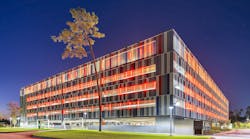Gensler's Leiserowitz: Employs holistic philosophy to foster clients' creativity, comfort
Walking into a new corporate space her team designed in River North for Whole Foods Market Inc., Nila Leiserowitz pointed out a long lunch table visible from the front entrance instead of hidden in a back room.
The 36,000-sf space, completed in the fall at 640 N. LaSalle St., evokes one of the retailer's natural food stores, with decorative grocery shelves, sustainable materials, polished concrete floors and wood beams.
If it weren't for a few cubicles and some offices, a visitor might try to check out with a few canned goods, and that's by design. Why does the grocer's Midwest regional office need to look like one of its stores?
"There's a consistency here around the story the company is trying to tell," said Leiserowitz, 58, who became regional managing principal in Chicago for San Francisco-based architecture and design giant Gensler a little more than a year ago. "You walk in and see blackboards and posters about an upcoming fundraiser, and the space seems to have life. It's dynamic and changing, and no space feels more important than another."
Gone -- long gone, in fact -- are the days when designing a corporate space meant slotting in some file cabinets and an impressive corner office.
A more technology-savvy, holistic philosophy informs the firm's work today, including its current job on the design team for the Rehabilitation Institute of Chicago's new research hospital at 630 N. McClurg Court.
In a nutshell, it's about making clients more comfortable, workers more creative or, in this case, patients healthier.
The Rehabilitation Institute tapped Gensler and Omaha-based firm HDR in June for the Streeterville high-rise project.
In a statement last summer announcing the deal, the institute's CEO, Dr. Joanne Smith, said the new hospital will set "a new benchmark for rehabilitation medicine in the world."
The goal is to bring the latest in rehabilitation research more directly into the patient setting.
It was the first major win for Leiserowitz since coming to Chicago after running the firm's Los Angeles-area office, where her clients included DreamWorks and Sony.
On its heels, the firm is going after other health-oriented clients.
A marathon runner and mountain climber, Leiserowitz refers to the business as "wellness and health," instead of the other way around, to emphasize the goal of keeping people healthy.
"Nila was central to winning the (Rehabilitation Institute) business and leading the effort" of sketching out how the patient spaces will accommodate innovative therapies and equipment while maintaining a comfortable, healing environment, said Lamar Johnson, the other regional managing principal for Gensler in Chicago. Together, Johnson and Leiserowitz are responsible for about 400 employees, including 210 in Chicago and the remainder in Minneapolis, La Crosse, Wis., and Detroit.
"We're the perfect matched set," Johnson said. "She's interiors, while I'm more of a core architecture and mixed-use guy. She handles HR issues, and I take the finance piece. She oversees Minneapolis, and I have Detroit," he said, referring to two of the region's other Midwest offices.
"I knew things were going to work out when people stopped asking both of us what to do about the same issue," he said. "For a while it was like we were the parents, and people would ask both of us for something, thinking that if they didn't like the answer from mom they could go to dad."
That kind of subterfuge is likely made difficult because Leiserowitz's and Johnson's offices are separated by a glass wall at Gensler's Loop office.
The glass is another form-following-function example, Leiserowitz said.
"It's about being very transparent," she said. "Our space is open.''
In fact, her office doesn't have a door, a reminder to staff that she's always accessible, Leiserowitz said.
Now at the top of the corporate interior design field at one of the world's largest architecture and design firms (debt-free Gensler logged $574 million in revenue last year and took on 500 new employees, giving it 3,200 as of the first quarter), Leiserowitz worked her way up the ladder and came of age when corner offices behind mahogany doors ruled the landscape.
That command-and-control image has slowly given way to more egalitarian spaces designed to reflect companies' individual missions and inspire creativity in workers, and Leiserowitz has been at the forefront of that trend.
While working her first job out of the University of Minnesota at a Minneapolis design firm, she met Gary Wheeler, a designer on staff at the university as it built a new law school, through a mutual friend.
They hit it off immediately, and when Wheeler left town for an extended European holiday, he asked Leiserowitz (then named Hildebrandt) to cover his duties with a professional organization to which they both belonged, the American Society of Interior Designers.
When he returned, he took her to lunch to thank her for stepping in.
"Halfway through lunch I turned to her and said, "I've decided to leave the university and go into business with a friend,' " he recalled. "She said, 'Who?' and I looked across the table and said, 'You.'
"And she looked right back at me and said, 'Well, that's good, because I had already decided to go into business with you,' " Wheeler said.
She was just 24 when they struck out on their own.
Over the next decade as she and Wheeler built the business, she also met and married Ron Leiserowitz.
"We met at a swimming pool" in 1984, Ron Leiserowitz said. "We just started talking and really hit it off. At one point I excused myself, went into the locker room and made a phone call to cancel my date with someone else so I could ask her out that night. Much later, Nila told me she had done the same thing."
A year later, they married, with Wheeler standing up for Nila during the ceremony.
About two years later, just as Wheeler-Hildebrandt was planning its 10-year anniversary party, Nila broke some bad news to her business partner: She wanted to sell her share of the company.
"It was extremely difficult," she said. "There were some hard feelings. It was a small community, and everyone knew us as Gary and Nila. I said to Gary that I needed to be looked at as an individual."
They argued through lawyers about the financial end of the breakup and for more than a year barely spoke.
"It was probably the most painful thing I've gone through in my career," Wheeler, now based in London, recalled. "It was almost like a divorce."
Eventually the pair patched things up, reconnecting through industry events, and today remain close friends.
Meanwhile, Nila and Ron moved to Chicago so Ron could take a commercial real estate job, and Nila made a clean break from design, spending a semester at John Marshall Law School.
The break didn't last long, however.
She joined design firm Perkins+Will in 1989 and hasn't looked back. It took her just two years to become the first woman on the firm's board.
She had spent nearly seven years at Perkins+Will when Andy Cohen, a Gensler executive director, asked her to meet him for a drink during a layover at O'Hare International Airport.
"We had heard of her for a long time as a top designer and, of course, we wanted to recruit her," Cohen said. After the meeting she joined Gensler Los Angeles in 1995.
About 18 months later, Gensler named her a workplace practice leader. She rose to the top of the Los Angeles office (then located in Santa Monica, Calif.) seven years ago.
In 2007 she won a coveted Designer of the Year award from the American Society of Interior Designers.
On paper, a casual observer might expect a hard-charging personality to accompany such a rocket launch of a career.
To the contrary, colleagues and friends say it is her warmth and empathy that gets her noticed.
"Nila is one of the most genuine people I know," Cohen said. "She's friendly, inquisitive, always asking about you and your life. It's why clients love to work with her."
Even in her avid hobby, mountain climbing, a more human side shows through.
On a 2010 trek to the Western Hemisphere's highest mountain, Argentina's Aconcagua, she made it to the highest camp but at the last moment decided against trying for the summit.
"I stopped at 19,600 feet. I was the oldest person in the group, was getting frostbite and I just had a gut feeling that I shouldn't" proceed, she said. "I'm a competitive person, but I'm competitive with myself. For me, 90 percent of the memory is the time you spend getting there, not the summit itself.
"I've been a pretty driven person my whole life," said the South Dakota-born daughter of a cattle broker, who used to accompany her dad when he called on ranchers.
"I used to watch the way he was with clients. He spoke with respect to their wives and families. It's from him that I learned to be authentic with people."
That side also comes out in her myriad community service projects.
Among them, she led a Gensler pro bono project last year in Haiti to rebuild a grammar school ravaged by a 2010 earthquake. Gensler donated the design, and Honeywell donated the construction. Recently, she's been networking with nonprofits about ways to make her mark in Chicago, including helping with the Young Women's Leadership Charter School.
Meanwhile, she and Ron are renovating a three-story, Victorian-era home in Lincoln Park, about two blocks from their previous Chicago home.
She feels no pressure to enslave herself to the Victorian style throughout the home. They're keeping some of the vintage flair, such as rosettes in the ceilings, wood moldings and original hardware, but modernizing the kitchen and baths and using modern furnishings, she said. It's a big departure from the couple's LA place, a midcentury modern.
So where does the designer think most homeowners go wrong in renovating their own spaces?
It's the same as in corporate design projects, she said.
"You start out as a team and clearly identify your design principles and what you think is important," she said.
"And then sometimes along the way you get sidetracked and don't stay true to your original design."
Most people blame budget factors when that happens, she said, but she calls that a cop out.
"Costs can always be brought in," she said, by substituting materials that can still deliver the right effect.
That's why, she said, she continually takes clients back to the original planning sessions when they first identified what their building projects were about. Get to the essence of how the space will be used day to day, she said.
"People do four things at work: learn, focus, socialize and collaborate," she said. "We create environments that support that and give people an opportunity to work in multiple ways." BD+C
--
This article originally appeared in the Chicago Tribune.


